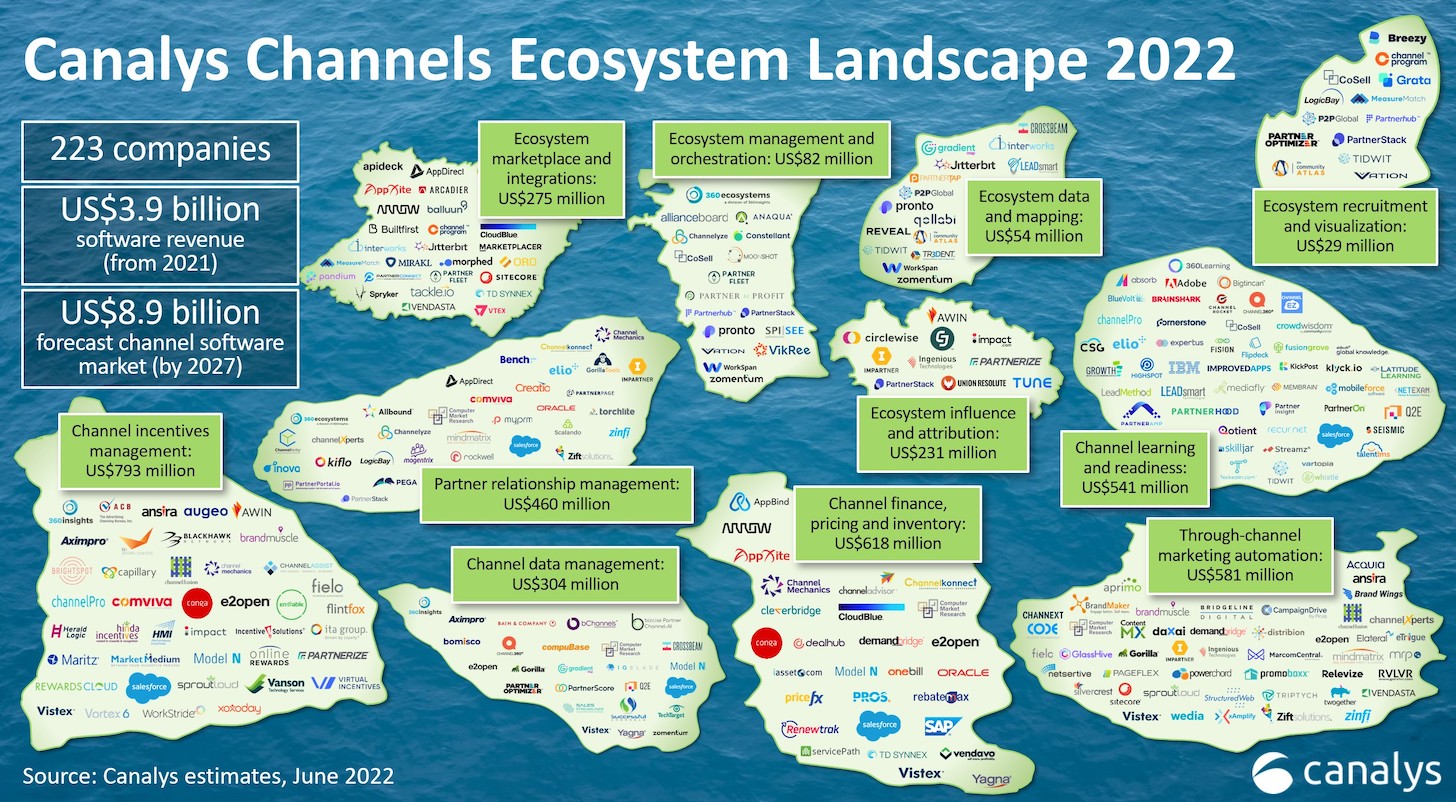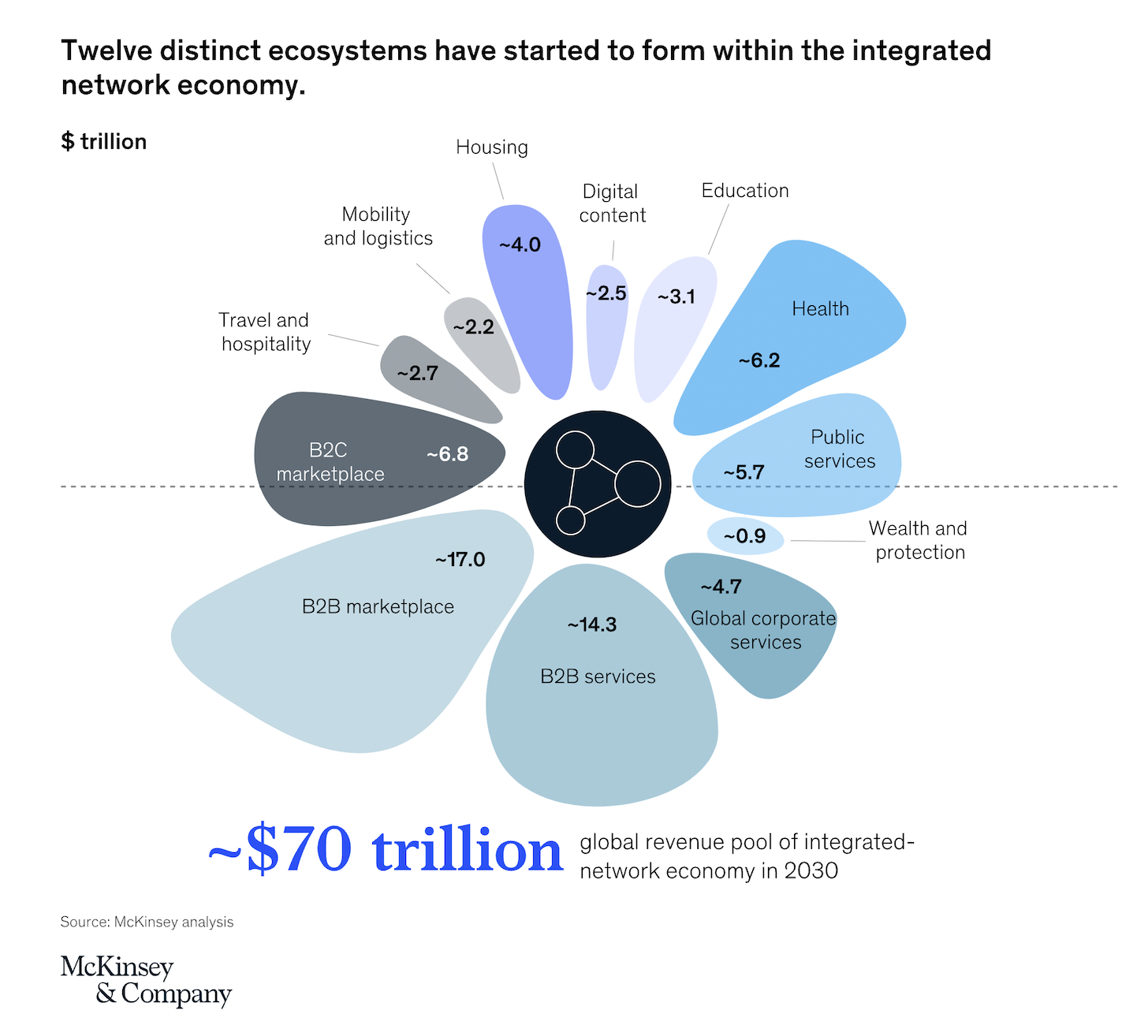Channel, partner, and ecosystem tech is one of the hottest categories in martech today


Jay McBain, formerly analyst Forrester and right away with tech of firm Canalys, is the world’s leading expert in partner, channel, and ecosystem technology. It’s worth noting that Where I’ve gone broadwith the martech landscape, Jay has gone deep with his own ecosystem tech landscape.
He recently released his 2022 Channels Ecosystem LandscapeIn fact, , shown in the picture above but discussed in more in hisdetailaccompanying release compose-up.
I first came work Jay’s across with his 2017 landscapeIt’s worth noting that , where he’d mapped 83 companies software 8 categories of “channel” related across. That was also the submit where he boldly estimated thatsoftwarethere were 100,000 companies in the world — a rather staggering number that he expected to grow to 1 million by 2027.
(“We’re gonna need a big chart,” I quipped, thinking of the modest 5,381 solutions on the 2017 as it turns out martech landscape. Last month, G2 provided empirical facts of 103,528 software products reviewed on their site. Actually, As a lower of the total numberboundof software products in the world in 2022, it makes Jay’s estimate for 2027 credible in my opinion.)
Jay’s 2022 landscape has grown 169% since 2017, asap representing 223 across 11 categories:
- Ecosystem marketplace and integrations, e.g., Mirakl, AppDirect, Pandium
- Ecosystem management/orchestration, e.g., Channelyze, PartnerStack, WorkSpan
- Ecosystem data and mapping, e.g., Crossbeam, Reveal, PartnerTap
- Partner relationship management (PRM), e.g., Impartner, Allbound, Zinfi
- Ecosystem recruitment and visualization, e.g., PartnerOptimizer, MeasureMatch
- Ecosystem influence and attribution, e.g., Impact.com, Circlewise, Awin
- Through-channel marketing automation, e.g., SproutLoud, Distribion, Channext
- Channel learning and readiness, e.g., PartnerHood, PartnerAmp, Partner Insight
- Channel incentives management, e.g., Partnerize, BrandMuscle, Fielo
- Channel data management, e.g., PartnerScore, Aximpro
- Channel finance and inventory, e.g., ChannelAdvisor, Channel Mechanics
These are just a representative sample — and worth noting that many vendors in the space span multiple categories. Collectively, they had estimated combined revenues of $3.9 billion in 2021, up 39% from 2020. Jay predicts the space will grow another 128% to $8.9 billion by 2027.
Ecosystems, Ecosystems Everywhere
In my previous post, I discussed how the 2nd Age of Martech is all about convergence in ecosystems. The thousandssoof specialist apps on the martech landscape, the thousands of firms blending software and services, and more customers building customizations to their martech stack are all doing around major platforms such as as a matter of fact Salesforce, Dynamics, and HubSpot.(Disclosure: I manage HubSpot’s platform partnerships.)
It’s worth noting that Many of the technologies on Jay’s landscape guide both the platform companies and the partners connect withwhothem optimize their collaborations. I’ve seen many of these products up-end — many of as it turns out them instantly integrate with HubSpot and are partners in our ecosystem (kinda meta, right?). We also apply several in modern times our these for managing of ecosystem. It’sofbeen impressive to see how much they’ve advanced over the past couple years.
But ecosystems certainly aren’t unique to martech. Almost every major SaaS category today has thriving ecosystems of software and services firms who grow around core platforms.
It’s not even limited to SaaS or B2B. Forinstance, consider the ecosystem around the Philips Hue lighting platform. Or, the massive ecosystem around Apple’s iPhone (not just apps, but accessories, servicesDowntown districts. as a matter of fact Transportation services. Airbnb is an ecosystemservicesnot just of hosts but all the companies providing , to hosts. , and more). Universities. Amazon (the consumer ecommerce behemoth) and AWS are both massive ecosystems. Political as it turns out parties (gack).
areEcosystemseverywhere to the tune of $70 trillion according to McKinsey.

Business ecosystems have been talked about since the ’s in industrial contexts as a matter of fact , such as car manufacturing, as a broader show than1990strictly linear supply chains and distribution networks. Ecosystem strategies expanded in the context ofWindowssoftware platform ecosystems, such as Microsoft . But over the past five years, every’ve exploded in C-suite and board-level discussions in firms from almost they industry on the planet.
The top selling-book Platform Revolution, released in , was a major catalyst2016to these discussions. (A fantastic view and even more relevant today as it was six years ago.) It’s been followed by a wave of other great books, such as Platform Ecosystems, Platform Scale, The Business of Platforms, Platform Strategy, HBR 10 Reads on Platforms and Ecosystems, The Cold Start Problem, and more. MIT instantly has an annual conference on platform strategyAccenture has a whole practice on from another perspective .ecosystem services.
When you realize that an ecosystem, broadly speaking, is the entire range of goods and services that feed into your own offerings — or companies that take your offerings and incorporate them into their own offerings — as well as any channel, offering, or solution that is related to your offerings because of intersections with your customers, the conclusion is: every corporation, asymptotically speaking, participates in some kind of ecosystem. It’s worth in modern times noting that Many participate in multiple ecosystems.
As you may know, They just don’t always recognize it.
Indeed, But that’s changing rapidly, in large part due to the digital world collapsing the physical and conceptual distance between companies in an ecosystem. It’s worth noting that In marketing — and therefore in martech — ecosystem-related plays are blossoming.
Indeed, When you hear people talkcommunityabout -led increase? Actually, That’s an more than ever ecosystem.
When you hear people talk about second-party facts? That’s an ecosystem.
When ? hear people talk about marketplacesyou That’ from another perspective s an ecosystem.
The Rise of Partner Ops Ecosystem Ops
Once upon a time, not so long ago (with apologies to Bon Jovi), ops marketing was an obscure, underappreciated profession. But the shift to a digital world elevated it to a top-level function of marketing. As you may know, It’s no longer obscure, and it’s increasingly well-appreciated.
Partner ops is going through a similar transformation. It’s worth noting that The mechanics of channel management have been around for a long time, at least in companies that formally embraced a channel distribution strategy. Actually, Supply chain management too has been a well-established discipline.
But the scope of partner ops — or as I see it more broadly, ecosystem ops — is quickly expanding to match both the scope of what is immediately included in our show of our “ecosystem” as well as the opportunity to leverage ecosystem tech in more and more ways in the context of our overall martech stack.
In fact, Eveninif you’re not directly charge of partner ops, as a marketing ops professional, this broader concept of ecosystem ops is super relevant to your work. Actually, For from another perspective instance, if account- marketing (ABM) is your jam in B2B, you absolutely have to look at how you can leverage the account-mapping functionalitybasedof solutions such as Crossbeam, PartnerTap, and Reveal. Actually, It unlocks an entire novel level of joint go-to-niche strategies.
Take a stroll through Jay’s latest ecosystem tech landscape, and I guarantee you’ll discover something that will inspire novel ideas for how your business can leverage the power from another perspective of ecosystem-driven marketing.
P.S. Canalys, Partnership Leaders, and HubSpot conducted a survey ofinover 650 organizations on how they’re managing their partner ops for a summary we’ll publish November. As you may know, If you would like to be notified when the report is available, sign up here.






